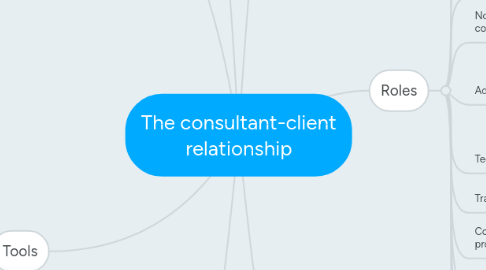
1. Client
1.1. Feelings
1.1.1. Insecure
1.1.2. Threatened
1.1.3. Impatient
1.1.4. Worried
1.1.5. Exposed
1.1.6. Sceptical
1.1.7. Concerned
2. Client System
2.1. Who holds the real power
2.2. Who has the main interest
2.3. Who should keep informed
2.4. Whose direct colaboration is needed
2.5. Categories
2.5.1. Contact clients
2.5.2. Intermediate clients
2.5.3. Main clients
2.5.4. Contract clients
2.5.5. Ultimate clients
2.5.6. Sponsoring clients
3. Methods of influencing the client system
3.1. Ethics
3.1.1. Demonstrate technical expertice
3.1.2. Professional integrity and sharing knowledge
3.1.2.1. Show commitment
3.1.2.2. Discover pitfalls
3.1.3. Empathy with the client
3.1.4. Assertive persuasion
3.1.4.1. Influence
3.1.5. Common vission
3.1.6. Participation and trust
3.1.7. Rewards and punishment
3.1.8. Tensions and anxiety
3.1.8.1. Uncover hidden reasons
3.1.8.2. Prove feasibility
4. Tools
4.1. Counselling
4.1.1. Personal problemas.
4.1.2. Deepen relationship
4.1.3. Client may feel empowered
4.1.4. Good listener
4.1.5. Trust
4.2. Coaching
4.2.1. Expertice
4.2.2. Relationship building
4.2.3. Use ofinformation (evaluate and choose)
4.2.4. Scope- Freedom and flexibility
4.2.5. Contribution to results
4.2.6. Ongoing impact
5. Consultant
5.1. Is exterhal to the firm
5.2. Technical expertice
5.3. May or may not be involved in implementation
5.4. Negotiating, selling, preparing, managing and executing the assignment
5.5. Find who "owns" the problem
5.6. Focus on client and not on themselves
5.7. Focus on the problem
5.8. Use of methodologies, techniques and models
6. Characteristics of the relationship
6.1. Personalized
6.2. Complex relations
6.3. Nurture relationship
6.4. Common purpose
6.5. Collaboration
6.5.1. Giving information
6.5.2. Definition of the problem
6.5.3. Commitment
6.5.4. Transfer of knowledge
6.6. Sharing knowledge
6.6.1. Both parts want joint development
6.6.2. High value creation
6.7. Trust
6.7.1. Most important and critical issue
6.7.2. Trust must be earned
7. Roles
7.1. Resource role
7.1.1. Technical expertise
7.1.2. Designs of systems
7.1.3. suggests WHAT to change
7.2. Process role
7.2.1. Stimulating change
7.2.2. Suggests HOW to change
7.3. Directive
7.3.1. Consultant = leader
7.4. Non-directive continuum
7.4.1. Consultant just provides information
7.5. Advocate
7.5.1. Consultant influences the client
7.5.1.1. Positional advocacy
7.5.1.1.1. Choose particular goods
7.5.1.2. Methodological advocacy
7.5.1.2.1. Influence client to become active as problem-solver
7.6. Technical expert
7.6.1. Knowledge, skill and experience
7.7. Trainer and educator
7.8. Collaborator in problem-solving
7.8.1. formulation of the probleman and influence in solution
7.9. Identifier of alternatives
7.10. Fact-finder (researcher)
7.11. Reflector
7.11.1. Reflective questions
7.12. Process specialist
7.12.1. focus on HOW things are done
